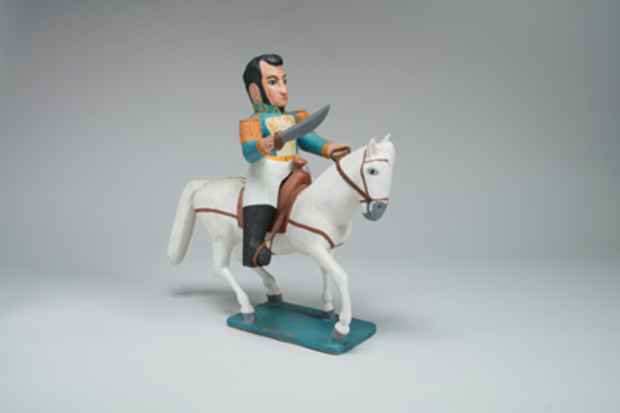“Self-Taught Art from Latin America and the Caribbean: The Aldemaro and Ana Romero Collection” Exhibition
Baruch College/Sidney Mishkin Gallery

[Image: Quinto M., Venezuela, Simon Bolivar, (c. 1980s) painted wood, 16 x 15 in.]
This event has ended.
The Mishkin Gallery at Baruch College presents the exhibition, Self-Taught Art from Latin America and the Caribbean: The Aldemaro and Ana Romero Collection.
Self-Taught Art from Latin America and the Caribbean: The Aldemaro and Ana Romero Collection features a variety of paintings and sculptures that were created by artists who lack professional education and training. Among the major characteristics of this art are simplicity, repetition, a geometrically erroneous sense of perspective, and the use of brilliant, saturated colors.
As pictured above, a small sculpture of Simon Bolivar, by Quinto M., is simplified in form, but depicted with a colorful uniform and a sword to emphasize his heroic role as the leader who established Venezuelan independence. In another piece of artwork in the exhibition, Haitian artist E. Marime painted every leaf individually, repeating its shape rather than creating clusters of foliage, for a jungle scene. The intensely colored jungle animals and plants appear stacked in space, without a traditional use of perspective.
Self-Taught Art: Becoming Part of the Art Historical Canon
Although it is sometimes confused with folk art, self-taught art usually lacks a clear cultural context, and it is often hard to identify by its geographic origin. Some self-taught artists are well-known, including the French painter Henri Rousseau (1944-1910), who was discovered by Pablo Picasso. Now, as self-taught art has become very popular with colleges and museums, it is possible for these unknown artists to become part of the art historical canon.
The Collectors
Aldemaro and Ana Romero are avid collectors of self-taught art and have traveled throughout Latin America. Their collection contains more than 50 paintings, sculptures, and examples of other crafts. The materials used in these artworks are diverse, and include oil paint on canvas, lithography, papier-mâché, bark, and wood. The Romero collection spans more than four decades, from the 1970s to the present, and it represents many countries: Brazil, Costa Rica, Cuba, Guatemala, Haiti, Mexico, Panama, and Venezuela.
“There are three reasons why my wife Ana and I have had a long-time interest in collecting this type of art. One is the intense colors they usually utilize that reminds us of the color of the tropics which we so much love,” said Aldemaro Romero, who is dean of Baruch College’s Weissman School of Arts and Sciences and professor of biology in the Department of Natural Sciences. “The second one is the authenticity of the artists who show things as they see them without filtering them through any kind of school training.”
Dean Romero added, “The third one is that they always bring us memories of the places where we have either lived or visited.”
Media
Schedule
from April 21, 2017 to May 19, 2017
Opening Reception on 2017-04-20 from 18:00 to 20:00